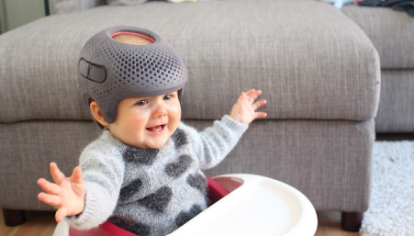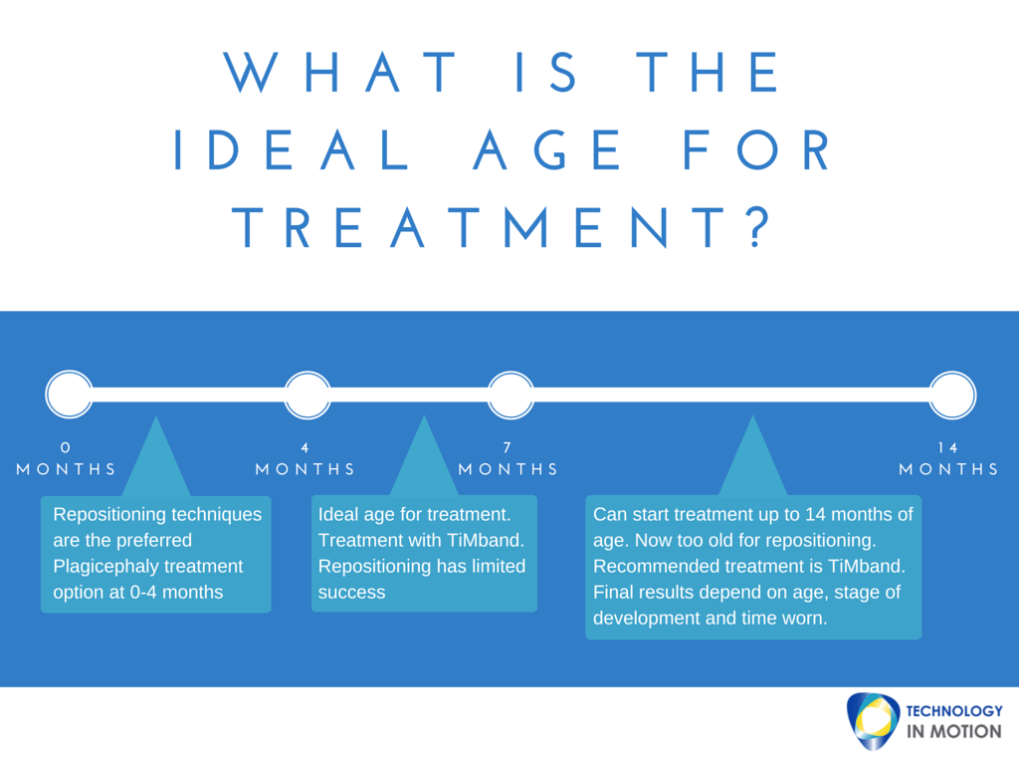

The ideal age to start a treatment is 4 to 7 months, but we will start to treat a baby up to the age of 14 months. Earlier starts give fuller and quicker results and this is because there is still opportunity for growth to bring about correction in head shape. After 14 months of age, we won't consider treatment as the flat head syndrome treatment we offer becomes notably less effective. After 14 months, the skull bones have begun to harden and the growth rate slows dramatically, giving less opportunity for correction using a TiMbandAir helmet.
For more information on the optimum age to treat flat head syndrome and the expected results for each stage of the treatment, read our informative blog on plagiocephaly treatment time.
Andria Donnison kindly shared her baby Coby’s flat head syndrome treatment story with us, raising awareness of the condition and the importance of second opinions. Andria first noticed something was wrong around 3 months of age and voiced her concerns to her health visitor who reassured her that Coby’s head shape would correct itself once he began to roll over. When Coby’s condition didn’t improve, Andria sought a second opinion from Technology in Motion who diagnosed Coby with severe plagiocephaly.
With the NHS only providing funding in exceptional circumstances, treatment for flat head syndrome can be an emotional and financial strain. Commenting on the initial financial difficulties encountered, Andria confessed “At first I was upset and also worried about the costs involved, but thanks to the support of our family, friends and the local community we managed to raise enough money for Coby’s helmet whilst raising awareness about the condition at the same time”.
And the results were fantastic, his orthotist Sandie Waddell was delighted with the change in Coby’s head shape noting that “he started with an asymmetry of 17mm, which improved to 4mm, and a CI (width to length ratio) of 97 percent, which improved to 87 percent”.
Andria was also thrilled with the results Coby achieved and urges other parents, “having had such a positive experience with Technology in Motion I always recommend that they get a second opinion, even if it’s just for peace of mind”.
There are different forms of flat head syndrome treatment available for babies and this is dependent on a number of factors such as the extent of the head shape deformity and the age of the baby. At Technology in Motion, we do not recommend using a TiMbandAir for babies under four months old as we believe repositioning techniques offer the best form of treatment at that age. However, in some cases, the head shape will not respond to repositioning techniques and a significant improvement will not be possible.
This will be when we may recommend helmet therapy as the best form of flat head syndrome treatment. Between 4 and 7 months is the ideal age for helmet therapy as repositioning techniques begin to have limited success. We offer flat head syndrome treatment up to fourteen months, however we recommended treatment as early as possible to achieve the best results for your baby. Depending on the age of the baby and the speed in which your baby’s head grows, treatment for flat head syndrome usually lasts from three to six months.
Highlighting again the importance of seeking a second opinion and getting the right treatment for your baby is Reihan’s flat head treatment story. His parents, Susan and Andrew, have been disappointed by the lack of awareness which surrounds the condition and the danger of falling outside the treatment window if parents are unaware of all the available treatment options for their baby following a diagnosis.
After Susan raised initial concerns at just two weeks, she was advised to try repositioning techniques, however both parents found this difficult and Reihan still showed a tendency to lie with his head to the right hand side. Then followed a number of unsuccessful visits to their GP and it wasn’t until Susan carried out her own research online that she discovered Technology in Motion. She recalled, “Without hesitation we made an appointment to take Reihan to see the lead clinician at the Technology in Motion clinic in Glasgow and thank goodness we did. We haven’t looked back since”.
Orthotist Sandie Waddell explained, “In two months he has achieved the goals that we set out to achieve. Reihan is responding extremely well to the treatment and we are all delighted.”
For more information on flat head syndrome treatment, visit our dedicated treatment page which identifies the windows of treatment we would recommend for babies with flat head syndrome, how helmet therapy works and our advice to help you find the right treatment for your baby.
If you think your baby may have flat head syndrome, or would simply like a second opinion from our leading orthotists, get in touch and book a free pre-assessment. We will be able to offer the best form of treatment for your baby and answer any other questions you may have about flat head syndrome and how flat head syndrome treatment works.


